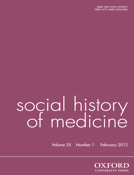-
Views
-
Cite
Cite
Valerie Worth-Stylianou, Cathy McClive and Nicole Pellegrin (eds.), Femmes en fleurs, femmes en corps. Sang, santé, sexualités, du Moyen Age aux Lumières, Social History of Medicine, Volume 25, Issue 1, February 2012, Pages 258–259, https://doi.org/10.1093/shm/hkr148
Close - Share Icon Share
Extract
The number of critical studies in English and French over the last twenty years on early modern conceptions and representations of the female body and women's sexuality has been impressive, and this volume of twelve papers bears testimony to the range and richness of the field. It is good to see, alongside chapters by pioneers such as Evelyne Berriot-Salvadore and Helen King, contributions from emerging scholars such as Stéphanie Gaudillat-Cautela and Elizabeth L'Estrange. All twelve papers are published in French, some translated from English, which in itself should facilitate further exchanges between English- and French-speaking scholars.
The volume is divided into three sections, each encompassing one aspect of women's experience of sexuality in early modern France: the preservation of virginity or youth, generation, and the violation or loss of sexual identity. The thematic and disciplinary breadth of compass is, paradoxically, both a strength and weakness of the volume. In the preface a forceful argument is put forward for an interdisciplinary analysis of the socio-cultural and ideological influences which have shaped the representations of the female body, yet, disappointingly, the individual chapters are conceived to be free-standing rather than in dialogue with each other. This would be understandable in a collection of conference papers, but is less so in a volume of collected essays. Consequently, across the chapters we are introduced to an extraordinarily wide array of primary texts – including conventual records, medical treatises, letters exchanged between princesses, recipe books and legal documents from trials for rape – but the synergies are not worked through for us. For example, the papers on princesses' letters and rape trials both usefully, but separately, observe the striking absence of detailed testimony by women of their individual sexual experiences. While the subtleties of textual representations of the female body are very interestingly explored in a number of papers, Evelyne Berriot-Salvadore and Lianne McTavish are alone in looking in detail at how we might read illustrations (in medical treatises). A broader survey of iconography of the female body would have been a valuable addition to the volume. The chronology of the period under consideration is unhelpfully broad. Individual papers (often concentrating on a century or part of a century) will undoubtedly interest various different readerships, but the overall coverage – spanning the thirteenth to the eighteenth centuries – makes any overarching synthesis impossible, and, perhaps as a result, few papers really address the issue of the significance of their specific choice of timeframe. We are left to wonder in most cases what results a study of similar materials from two centuries earlier or later might yield.




